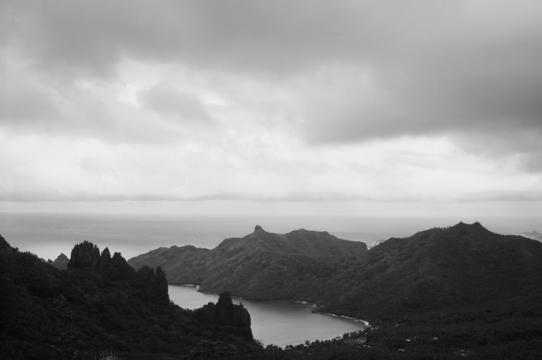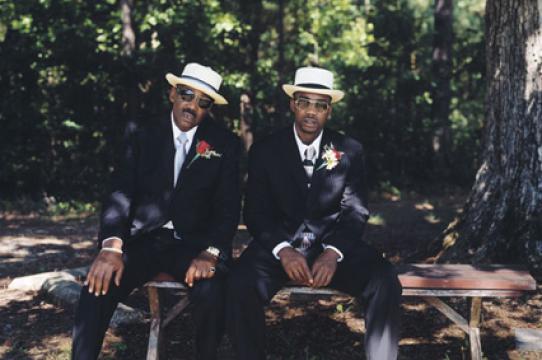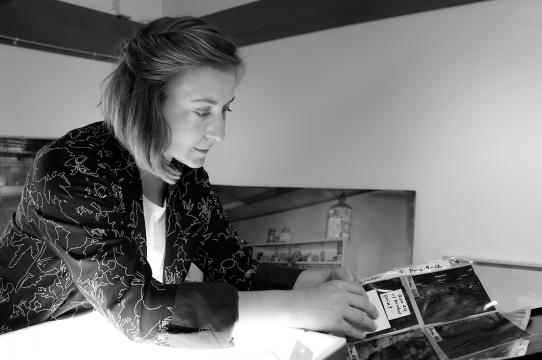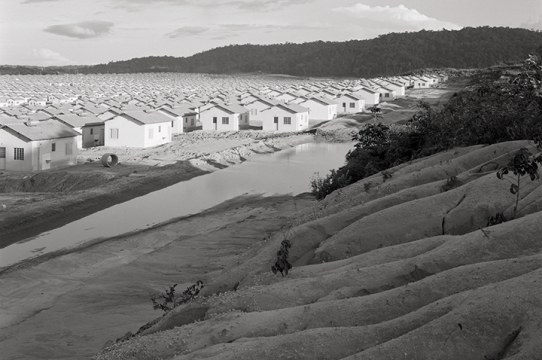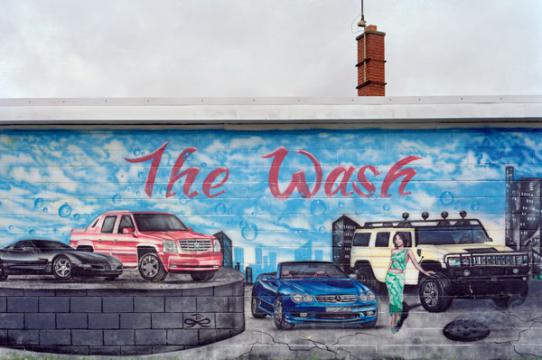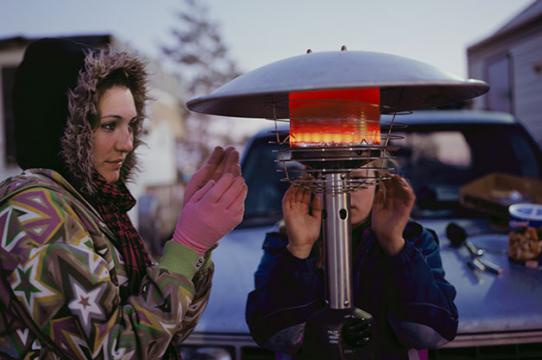Assistant Professor Karolina Karlic is no stranger to adapting to new situations – the Polish born, American educated photographer moved to the states at a very young age. Her work has focused on industry and diaspora, the effects of social upheaval, and has led her to capture imagery all over the country and various parts of the world, including her native Poland, Ukraine, Sierra Leone, French Polynesia, and most recently Brazil.
With both of her parents being professors, Karlic’s father was able to move his family to Detroit from Poland after being offered a teaching position at Wayne State University. “Very early on, I was attracted to the idea of representation,” she says. “After we landed in Detroit, I was trying to figure out what this place really was.”
LEARNING ABOUT A FAMILY'S BLACK EXPERIENCE
One of her first introductions to American culture came from neighbors who were from Mississippi, and their personal experiences of migrating from the South launched her interest in how diasporas are created. “This family taught me about their American experience, their Black experience in America, their perspective, and their own migration from one place to another in search of something better,” she says. “Because we didn’t have other family members here, this family from Mississippi became an extended part of my own.”
Growing up, Karlic found herself being drawn to art and photography. She used her parents’ Minolta camera to take photos of her surroundings. “I always thought it was a device that connected me with the world out there that I didn’t quite fit into. And I think that carries on to this day. Now, I understand what it means to build a relationship with subject matter.”
Karlic credits her high school photography teacher for inspiring her to become a serious photographer. “I didn’t realize I could actually have a future in the arts until this teacher told me I could,” she says. “I started photographing friends and places all around Detroit, and then printing photos after school in the dark room. I also got a camcorder and shot videos.”
FREEDOM TO FOCUS ON PERSONAL NARRATIVES
When it came time to go to college, she chose to study at the Minneapolis College of Art and Design, which had a very traditional emphasis on the arts and solidified her passion for photography. “The professors there absolutely planted the seed on what it meant to be a photographer, how to go out in the world as a photographer, and to be socially responsible.” After graduating with a BFA, she was invited by her professor and mentor, Katherine Turczan, to travel to Ukraine to assist with the professor’s ongoing photography project. “Every summer Katherine would go Ukraine to photograph and research into where her family had come from. That was very influential for me…to know that you can have the freedom to focus on your own personal narratives.”
And it was that very influence that led Karlic to start thinking about her own personal journey and Polish heritage. She was given a text by another professor at MCAD, Vince Leo, which featured the writings of artist Allan Sekula, a photographer connected to Polonia who at the time was teaching at CalArts. “I sought him out and did my graduate studies at CalArts, working closely with him and [photographer/Associate Dean] Andrew Freeman. Soon after I was introduced to [Professor Emerita/Art Historian] Sally Stein. They were the biggest influences for me.”
LOOKING FOR WAYS TO TELL HER PERSONAL STORY
During this time, Karlic travelled to Poland and began her personal project Primer/Elementarz. “A primer is the first book you’re given in elementary school in Poland,” she explains. “The concept was to tell my personal story within the context of a shifting environment and reality. This reality involved the U.S. economic recession and, in part, the landscape of Detroit. However I didn’t want to depict the city the way it had been in recent times – a portrait of decay. I started looking at ways to reveal my own life’s primer, or written and visual narrative, that included the individuals in my life and workers in the auto industry. This then evolved into my personal story and my family’s involvement in this complex industrial landscape.”
Karlic became more and more interested in how people are moved around due to shifts in industry. She started looking into the Henry Ford archives and found scores of images that looked like family photo albums, but turned out to be binders of information picturing workers who were sent from Ford’s factories in Michigan during the late 1920s to start a new company town and rubber-manufacturing plantation in the Brazilian Amazon.
HENRY FORD'S IMPACT
Named “Fordlândia”, Henry Ford made a deal with the Brazilian government in 1927 to acquire almost 2.5 million acres of land in the Amazon so he could grow his own rubber trees. “One of the reasons the indigenous peoples were enticed to work for the Ford Motor Company was because they would get superior medical care from his hospital,” says Karlic. “Everything was brought on freights down the Amazon River. It was fascinating to me, this idea of Americanism and Ford’s motivation to create a new kind of worker.”
“The plantations were testaments to the agricultural innovations and commercial cultivation of the jungle. However, they were also marked with failures, most notably Ford’s attempt to impose an American work schedule and lifestyle on the native Brazilians.”
Karlic also became interested in the role that race played in what turned out be a total fiasco, and visited the remains of Fordlândia and Belterra to find out more about its impact on the area. “The hospital and other buildings were destroyed or fell apart years ago, but people still live in what’s left of the worker houses,” she says. “I had this idea of how to engage with this space without it turning into a look at the past, or a ‘once was’. I focused on the lives of the individuals who are there now and photographed how Ford had also influenced other sites of natural resource based labor.” Her photography project and film Rubberlands emerged from that experience. “There are multiple facets within this body of work,” Karlic says of Rubberlands, noting that “it is an ongoing process which is always very exciting!”
After earning her MFA, Karlic taught at UC San Diego’s Visual Art Department. She has been the recipient of numerous fellowships and awards, including the John Simon Guggenheim Memorial Foundation Fellowship, the Cultural Exchange International Fellowship of the Los Angeles Department of Cultural Affairs and Sacatar Foundation, and has been a Light Work Artist in Residence.
TEACHING PHOTOGRAPHY IN SIERRA LEONE
Living in Los Angeles allowed her to connect to many talented artists and proved to be a robust resourceful city. “Although, I was so self-involved with my work and living in LA,” says Karlic. “I sought less conventional opportunities. A close friend was doing an art therapeutic program in Sierra Leone, so I thought about how great it would be to do a photography program there. So I started, Kids and Kameras, a photography curriculum to be taught abroad using minimal resources.” Karlic designed the curriculum with two primary goals: to share the power of image making, and to empower youth to use photography and video as a tool for telling their own stories and communicating their traumas to a larger audiences.
She started by getting a local photography store to donate point and shoot digital cameras, portable printers and inks. She also lead the fundraising effort to buy various art supplies, and then packed everything up, and made the long journey to Freetown to teach. “We wanted to explore how everyone could tell their story through writing, painting, spoken word, and how to teach a child in Sierra Leone to have that experience through photography,” says Karlic. “We also wanted the students to have photographic prints that were tangible and that they could actually hold in their hand.”
“With digital photography now, photography itself has become democratized. We have a privileged relationship to it, however it is mostly limited to images being reproduced and viewed on electronic monitors” she observes, “It was important for me to address that. Teaching there was a really beautiful experience. It taught me a lot about social responsibility as a photographer and educator.”
"UCSC IS THE PERFECT PLACE FOR ME TO GROW"
Karlic really enjoyed her time teaching at UC San Diego and is thrilled to be at UC Santa Cruz. Having lived in California for many years now, she’s interested in the photographic history of the West, it’s photographic representation of labor, diaspora, and looks forward to taking students out in the field to photograph in and around the UC Natural Reserve sites.
“UCSC is a perfect place for me to grow as a photographer, artist, and educator and to continue building on my work…immigration, labor, social engagement and environmental practices…I can’t really think of a better place that fits my interests.” Karlic wants to give all of her students the opportunity to be inspired by photography and also to fall in love with the medium. She looks forward to showing them how photography can be a tool to tell their own stories.
“I’m completely honored to be amongst the legacy of Angela Davis, and all of the amazing legacies that have emerged from here,” she says. “If I can have a tenth or even a hundredth of the impact that those individuals have had, then I’ll be happy!”



